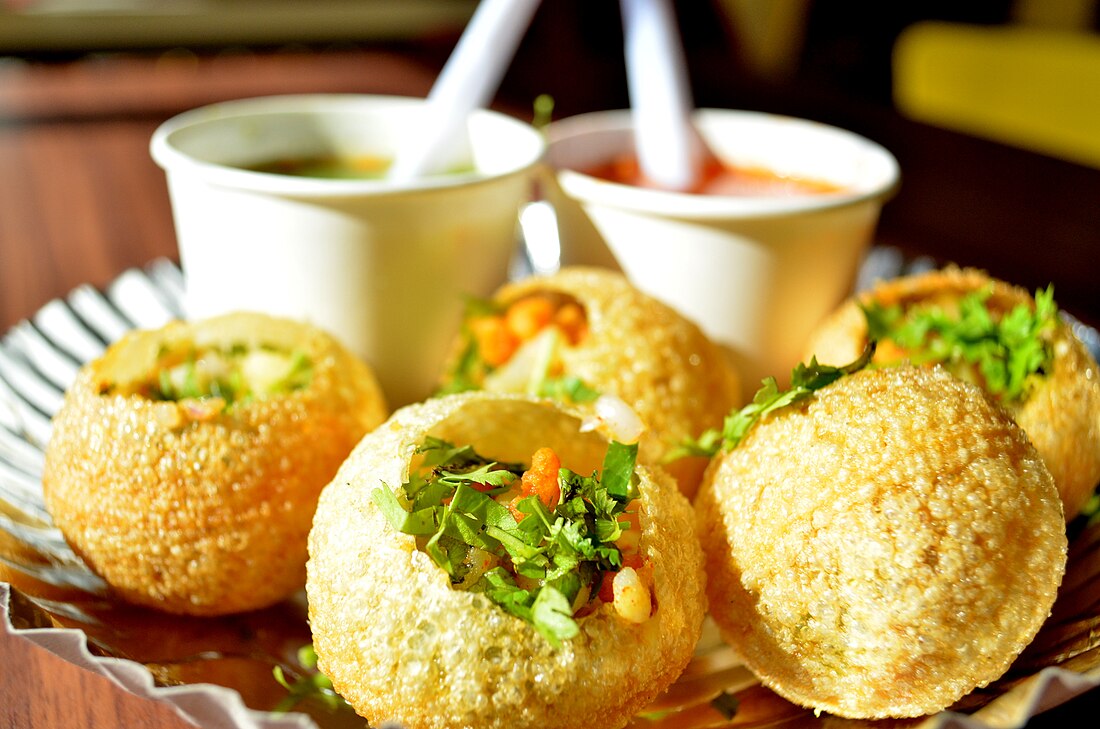Panipuri
Indian street food also called golgappe From Wikipedia, the free encyclopedia
Panipuri or golgappa is a deep-fried breaded hollow spherical shell - about 1 inch (25 mm) in diameter - filled with a combination of potatoes, raw onions, chickpeas, and spices. It is a common snack and street food in the Indian subcontinent.[2] It is often flavoured with chili powder, chaat masala, herbs, and many other spices.[3][4][5]
 Pani puri | |
| Alternative names | Golgappa, gol-gappa or gappa (Delhi, Punjab) Fochaka, phuchka, phuska, puska (Bengal, Bihar, North East India) Gup-chup (Odisha, Jharkhand and Chhattisgarh) Pani-patashi/pani-puri/pani-ke-batashe/padake/fulki/pakodi (Gujarat, Haryana, Madhya Pradesh, Maharashtra, Sindh, Uttar Pradesh, Jalpooree (India)[1] |
|---|---|
| Type | Snack |
| Place of origin | India |
| Region or state | South Asia |
| Main ingredients | Flour, spiced water, onions, potatoes, chickpeas, herbs and spices |
| Variations | Sev puri, Puri |
Names
Panipuri has many regional names in the Indian subcontinent:[1][6] Maharashtra and South India: panipuri; Haryana: pani-patashi; Madhya Pradesh: fulki; Uttar Pradesh: pani-ke-batashe/padake; Assam: phuska/puska; Gujarat: pakodi; Odisha: gup-chup; Delhi: golgappa/phuchka; Bengal: phuchka and Bihar: jalpooree/phuchka.
History
According to culinary anthropologist Kurush Dalal, chaat originated in the North Indian region of what is now Bihar. The origins of golgappa trace back to India. He also noted that it possibly originated from Raj-Kachori: an accidentally-made smaller puri giving birth to panipuri.[7] Panipuri spread to the rest of India mainly due to the migration of people from one part of the country to another in the 20th century.[4]
On 10 March 2005, the word "panipuri" was added to the Oxford English Dictionary.[8]
Evolution over time
Summarize
Perspective

Pani puri has evolved significantly over time. Also known as "golgappa," the dish consists of a small, hollow, fried wheat and/or semolina shell filled with spiced mashed potatoes and served with either a green or a brown-coloured dipping water; or both. This "water" is technically a diluted chutney. Over time, variations of the filling and the flavoured water emerged, reflecting the regional preferences and availability of ingredients. The flavoured water, also known as the "pani," is an essential component of the dish and is often the main source of flavour.
The brown water is known throughout India as khatta meetha pani, which translates to as "sweet and sour water". The main composition of this water is tamarind and jaggery. The hotter alternative to this water, which is also typically the standard dipping green liquid for this dish, is known as theeka pani, which means "spicy water". It consists of herbs like mint and coriander along with green chillies. Both waters can include a garnishing of boondi, a concoction made of fried chickpea flour.[9] Some regional variations also use sweet flavours like fruit juices or dates, as well as many optional toppings like sev.[9]
Bangarapet panipuri is renowned for its distinctive white-colored pani, retaining a spicy kick that has been traditionally handed down through generations.[10]
Gallery
- Sooji Puri used in panipuri
- Homemade panipuri
See also
Wikimedia Commons has media related to Panipuri.
References
Wikiwand - on
Seamless Wikipedia browsing. On steroids.







